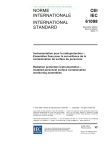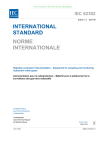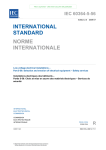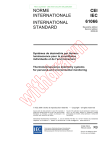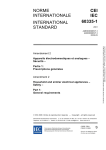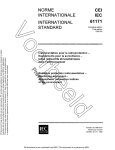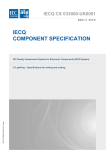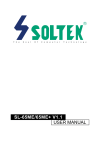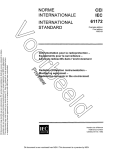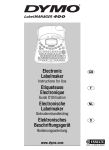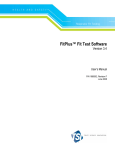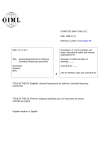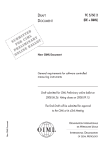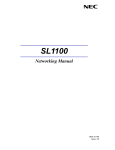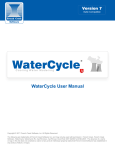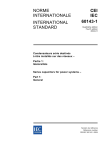Download INTERNATIONAL STANDARD IEC 61000-6-2
Transcript
INTERNATIONAL STANDARD IEC 61000-6-2 Second edition 2005-01 Electromagnetic compatibility (EMC) – Part 6-2: Generic standards – Immunity for industrial environments This English-language version is derived from the original bilingual publication by leaving out all French-language pages. Missing page numbers correspond to the Frenchlanguage pages. Reference number IEC 61000-6-2:2005(E) Publication numbering As from 1 January 1997 all IEC publications are issued with a designation in the 60000 series. For example, IEC 34-1 is now referred to as IEC 60034-1. Consolidated editions The IEC is now publishing consolidated versions of its publications. For example, edition numbers 1.0, 1.1 and 1.2 refer, respectively, to the base publication, the base publication incorporating amendment 1 and the base publication incorporating amendments 1 and 2. Further information on IEC publications The technical content of IEC publications is kept under constant review by the IEC, thus ensuring that the content reflects current technology. Information relating to this publication, including its validity, is available in the IEC Catalogue of publications (see below) in addition to new editions, amendments and corrigenda. Information on the subjects under consideration and work in progress undertaken by the technical committee which has prepared this publication, as well as the list of publications issued, is also available from the following: • IEC Web Site (www.iec.ch) • Catalogue of IEC publications The on-line catalogue on the IEC web site (www.iec.ch/searchpub) enables you to search by a variety of criteria including text searches, technical committees and date of publication. On-line information is also available on recently issued publications, withdrawn and replaced publications, as well as corrigenda. • IEC Just Published This summary of recently issued publications (www.iec.ch/online_news/ justpub) is also available by email. Please contact the Customer Service Centre (see below) for further information. • Customer Service Centre If you have any questions regarding this publication or need further assistance, please contact the Customer Service Centre: Email: [email protected] Tel: +41 22 919 02 11 Fax: +41 22 919 03 00 INTERNATIONAL STANDARD IEC 61000-6-2 Second edition 2005-01 Electromagnetic compatibility (EMC) – Part 6-2: Generic standards – Immunity for industrial environments IEC 2005 Copyright - all rights reserved No part of this publication may be reproduced or utilized in any form or by any means, electronic or mechanical, including photocopying and microfilm, without permission in writing from the publisher. International Electrotechnical Commission, 3, rue de Varembé, PO Box 131, CH-1211 Geneva 20, Switzerland Telephone: +41 22 919 02 11 Telefax: +41 22 919 03 00 E-mail: [email protected] Web: www.iec.ch Com mission Electrotechnique Internationale International Electrotechnical Com m ission Международная Электротехническая Комиссия PRICE CODE For price, see current catalogue N 61000-6-2 IEC:2005 –3– CONTENTS FOREWORD ........................................................................................................................5 INTRODUCTION ..................................................................................................................9 1 Scope and object..........................................................................................................11 2 Normative references ...................................................................................................13 3 Terms and definitions ...................................................................................................13 4 Performance criteria .....................................................................................................15 5 Conditions during testing ..............................................................................................17 6 Product documentation .................................................................................................17 7 Applicability..................................................................................................................19 8 Immunity test requirements...........................................................................................19 Bibliography .......................................................................................................................29 Figure 1 – Examples of ports ..............................................................................................15 Table 1 – Immunity – Enclosure ports .................................................................................21 Table 2 – Immunity – Signal ports .......................................................................................23 Table 3 – Immunity – Input and output DC power ports........................................................25 Table 4 – Immunity – Input and output AC power ports ........................................................27 61000-6-2 IEC:2005 –5– INTERNATIONAL ELECTROTECHNICAL COMMISSION ____________ ELECTROMAGNETIC COMPATIBILITY (EMC) – Part 6-2: Generic standards – Immunity for industrial environments FOREWORD 1) The International Electrotechnical Commission (IEC) is a worldwide organization for standardization comprising all national electrotechnical committees (IEC National Committees). The object of IEC is to promote international co-operation on all questions concerning standardization in the electrical and electronic fields. To this end and in addition to other activities, IEC publishes International Standards, Technical Specifications, Technical Reports, Publicly Available Specifications (PAS) and Guides (hereafter referred to as “IEC Publication(s)”). Their preparation is entrusted to technical committees; any IEC National Committee interested in the subject dealt with may participate in this preparatory work. International, governmental and nongovernmental organizations liaising with the IEC also participate in this preparation. IEC collaborates closely with the International Organization for Standardization (ISO) in accordance with conditions determined by agreement between the two organizations. 2) The formal decisions or agreements of IEC on technical matters express, as nearly as possible, an international consensus of opinion on the relevant subjects since each technical committee has representation from all interested IEC National Committees. 3) IEC Publications have the form of recommendations for international use and are accepted by IEC National Committees in that sense. While all reasonable efforts are made to ensure that the technical content of IEC Publications is accurate, IEC cannot be held responsible for the way in which they are used or for any misinterpretation by any end user. 4) In order to promote international uniformity, IEC National Committees undertake to apply IEC Publications transparently to the maximum extent possible in their national and regional publications. Any divergence between any IEC Publication and the corresponding national or regional publication shall be clearly indicated in the latter. 5) IEC provides no marking procedure to indicate its approval and cannot be rendered responsible for any equipment declared to be in conformity with an IEC Publication. 6) All users should ensure that they have the latest edition of this publication. 7) No liability shall attach to IEC or its directors, employees, servants or agents including individual experts and members of its technical committees and IEC National Committees for any personal injury, property damage or other damage of any nature whatsoever, whether direct or indirect, or for costs (including legal fees) and expenses arising out of the publication, use of, or reliance upon, this IEC Publication or any other IEC Publications. 8) Attention is drawn to the Normative references cited in this publication. Use of the referenced publications is indispensable for the correct application of this publication. 9) Attention is drawn to the possibility that some of the elements of this IEC Publication may be the subject of patent rights. IEC shall not be held responsible for identifying any or all such patent rights. International Standard IEC 61000-6-2 has been prepared by IEC technical committee 77: Electromagnetic compatibility. This second edition cancels and replaces the first edition published in 1999. It constitutes a technical revision. Specific technical changes have been introduced to Tables 1 to 4. The frequency range for tests according to IEC 61000-4-3 has been extended above 1 GHz according to technologies used in this frequency area. The use of TEM waveguide testing according to IEC 61000-4-20 has been introduced for certain products and the testing requirements according to IEC 61000-4-11 have been amended significantly. 61000-6-2 IEC:2005 –7– The text of this standard is based on the following documents: FDIS Report on voting 77/295/FDIS 77/298/RVD Full information on the voting for the approval of this standard can be found in the report on voting indicated in the above table. This publication has been drafted in accordance with the ISO/IEC Directives, Part 2. The committee has decided that the contents of this publication will remain unchanged until the maintenance result date indicated on the IEC web site under "http://webstore.iec.ch" in the data related to the specific publication. At this date, the publication will be • • • • reconfirmed; withdrawn; replaced by a revised edition, or amended. 61000-6-2 IEC:2005 –9– INTRODUCTION IEC 61000 is published in separate parts according to the following structure: Part 1: General General considerations (introduction, fundamental principles) Definitions, terminology Part 2: Environment Description of the environment Classification of the environment Compatibility levels Part 3: Limits Emission limits Immunity limits (insofar as these limits do not fall under the responsibility of the product committees) Part 4: Testing and measurement techniques Measurement techniques Testing techniques Part 5: Installation and mitigation guidelines Installation guidelines Mitigation methods and devices Part 6: Generic standards Part 9: Miscellaneous Each part is further subdivided into several parts, published either as International Standards or as technical specifications or technical reports, some of which have already been published as sections. Others will be published with the part number followed by a dash and a second number identifying the subdivision (example: 61000-6-1). 61000-6-2 IEC:2005 – 11 – ELECTROMAGNETIC COMPATIBILITY (EMC) – Part 6-2: Generic standards – Immunity for industrial environments 1 Scope and object This part of IEC 61000 for EMC immunity requirements applies to electrical and electronic apparatus intended for use in industrial environments, as described below. Immunity requirements in the frequency range 0 Hz to 400 GHz are covered. No tests need to be performed at frequencies where no requirements are specified. This generic EMC immunity standard is applicable if no relevant dedicated product or product-family EMC immunity standard exists. This standard applies to apparatus intended to be connected to a power network supplied from a high or medium voltage transformer dedicated to the supply of an installation feeding manufacturing or similar plant, and intended to operate in or in proximity to industrial locations, as described below. This standard applies also to apparatus which is battery operated and intended to be used in industrial locations. The environments encompassed by this standard are industrial, both indoor and outdoor. Industrial locations are in addition characterised by the existence of one or more of the following: – industrial, scientific and medical (ISM) apparatus (as defined in CISPR 11); – heavy inductive or capacitive loads are frequently switched; – currents and associated magnetic fields are high. The object of this standard is to define immunity test requirements for apparatus defined in the scope in relation to continuous and transient, conducted and radiated disturbances, including electrostatic discharges. The immunity requirements have been selected to ensure an adequate level of immunity for apparatus at industrial locations. The levels do not, however, cover extreme cases, which may occur at any location, but with an extremely low probability of occurrence. Not all disturbance phenomena have been included for testing purposes in this standard, but only those considered as relevant for the equipment covered by this standard. These test requirements represent essential electromagnetic compatibility immunity requirements. NOTE 1 Information on other disturbance phenomena is given in IEC 61000-4-1. Test requirements are specified for each port considered. NOTE 2 Safety considerations are not covered by this standard. NOTE 3 In special cases, situations will arise where the level of disturbances may exceed the levels specified in this standard e.g. where an apparatus is installed in proximity to ISM equipment as defined in CISPR 11 or where a hand-held transmitter is used in close proximity to an apparatus. In these instances, special mitigation measures may have to be employed. 61000-6-2 IEC:2005 – 13 – NOTE 4 The industrial environment may be changed by special mitigation measures. Where such measures can be shown to produce an electromagnetic environment equivalent to the residential, commercial or light-industrial environment, then the generic standard for this environment, or the relevant product standard, should be applied. 2 Normative references The following referenced documents are indispensable for the application of this document. For dated references, only the edition cited applies. For undated references, the latest edition of the referenced document (including any amendments) applies. IEC 60050-161, International Electrotechnical Vocabulary (IEV) – Chapter 161: Electromagnetic compatibility IEC 61000-4-2, Electromagnetic compatibility (EMC) – Part 4: Testing and measurement techniques – Section 2: Electrostatic discharge immunity test IEC 61000-4-3, Electromagnetic compatibility (EMC) – Part 4-3: Testing and measurement techniques – Radiated, radio-frequency, electromagnetic field immunity test IEC 61000-4-4, Electromagnetic compatibility (EMC) – Part 4-4: Testing and measurement techniques – Electrical fast transient/burst immunity test IEC 61000-4-5, Electromagnetic compatibility (EMC) – Part 4: Testing and measurement techniques – Section 5: Surge immunity test IEC 61000-4-6, Electromagnetic compatibility (EMC) – Part 4-6: Testing and measurement techniques – Section 6: Immunity to conducted disturbances, induced by radio-frequency fields IEC 61000-4-8, Electromagnetic compatibility (EMC) – Part 4: Testing and measurement techniques – Section 8: Power frequency magnetic field immunity test IEC 61000-4-11, Electromagnetic compatibility (EMC) – Part 4-11: Testing and measurement techniques – Voltage dips, short interruptions and voltage variations immunity tests CISPR 22, Information technology equipment – Radio disturbance characteristics – Limits and methods of measurement 3 Terms and definitions For the purposes of this document, the terms and definitions given in IEC 60050-161 as well as the following definitions apply. NOTE Additional definitions related to EMC and to relevant phenomena are given in other IEC and CISPR publications. 3.1 port particular interface of the specified apparatus with the external electromagnetic environment (see Figure 1) NOTE In some cases different ports may be combined. 61000-6-2 IEC:2005 – 15 – Enclosure port Signal port AC power port Apparatus DC power port IEC 072/05 Figure 1 – Examples of ports 3.2 enclosure port physical boundary of the apparatus which electromagnetic fields may radiate through or impinge on 3.3 cable port port at which a conductor or a cable is connected to the apparatus NOTE Examples are signal and power ports. 3.4 signal port port at which a conductor or cable intended to carry signals is connected to the apparatus NOTE Examples are analog inputs, outputs and control lines; data busses; communication networks etc. 3.5 power port port at which a conductor or cable carrying the primary electrical power needed for the operation (functioning) of an apparatus or associated apparatus is connected to the apparatus 3.6 long distance lines lines connected to a signal port and which inside a building are longer than 30 m, or which leave the building (including lines of outdoor installations) 4 Performance criteria The variety and the diversity of the apparatus within the scope of this standard makes it difficult to define precise criteria for the evaluation of the immunity test results. If, as a result of the application of the tests defined in this standard, the apparatus becomes dangerous or unsafe, the apparatus shall be deemed to have failed the test. A functional description and a definition of performance criteria, during or as a consequence of the EMC testing, shall be provided by the manufacturer and noted in the test report, based on one of the following criteria for each test as specified in Tables 1 to 4: 61000-6-2 IEC:2005 – 17 – a) Performance criterion A: The apparatus shall continue to operate as intended during and after the test. No degradation of performance or loss of function is allowed below a performance level specified by the manufacturer, when the apparatus is used as intended. The performance level may be replaced by a permissible loss of performance. If the minimum performance level or the permissible performance loss is not specified by the manufacturer, either of these may be derived from the product description and documentation and what the user may reasonably expect from the apparatus if used as intended. b) Performance criterion B: The apparatus shall continue to operate as intended after the test. No degradation of performance or loss of function is allowed below a performance level specified by the manufacturer, when the apparatus is used as intended. The performance level may be replaced by a permissible loss of performance. During the test, degradation of performance is however allowed. No change of actual operating state or stored data is allowed. If the minimum performance level or the permissible performance loss is not specified by the manufacturer, either of these may be derived from the product description and documentation and what the user may reasonably expect from the apparatus if used as intended. c) Performance criterion C: Temporary loss of function is allowed, provided the function is self-recoverable or can be restored by the operation of the controls. 5 Conditions during testing The equipment under test (EUT) shall be tested in the expected most susceptible operating mode e.g. identified by performing limited pre-tests. This mode shall be consistent with normal applications. The configuration of the test sample shall be varied to achieve maximum susceptibility consistent with typical applications and installation practice. If the apparatus is part of a system, or can be connected to auxiliary apparatus, the apparatus shall be tested while connected to the minimum representative configuration of auxiliary apparatus necessary to exercise the ports in a similar manner to that described in CISPR 22. In cases where a manufacturer's specification requires external protection devices or measures which are clearly specified in the user's manual, the test requirements of this standard shall be applied with the external protection devices or measures in place. The configuration and mode of operation during the tests shall be precisely noted in the test report. It is not always possible to test every function of the apparatus; in such cases the most critical mode(s) of operation shall be selected. If the apparatus has a large number of similar ports or ports with many similar connections, a sufficient number shall be selected to simulate actual operating conditions and to ensure that all the different types of termination are covered. The tests shall be carried out at one single set of parameters within the operating ranges of temperature, humidity and atmospheric pressure specified for the product and at the rated supply voltage, unless otherwise indicated in the basic standard. 6 Product documentation If the manufacturer is using his own specification for an acceptable level of EMC performance or degradation of EMC performance during or after the testing required by this standard, this specification shall be provided in the product documentation available to the user. 61000-6-2 IEC:2005 7 – 19 – Applicability The application of tests for evaluation of immunity depends on the particular apparatus, its configuration, its ports, its technology and its operating conditions. Tests shall be applied to the relevant ports of the apparatus according to Tables 1 to 4. Tests shall only be carried out where the relevant ports exist. It may be determined from consideration of the electrical characteristics and usage of a particular apparatus that some of the tests are inappropriate and, therefore, unnecessary. In such a case, it is required that the decision and justification not to test be recorded in the test report. 8 Immunity test requirements The immunity test requirements for apparatus covered by this standard are given on a port by port basis. Tests shall be conducted in a well-defined and reproducible manner. The tests shall be carried out individually as single tests in sequence. The tests may be performed in any order. The description of the test, relevant generator, appropriate methods, and the set-up to be used are given in basic standards, which are referred to in the following tables. The contents of these basic standards are not repeated here, however modifications or additional information needed for the practical application of the tests are given in this standard. Environmental phenomena 1.1 1.2 1.3 1.5 Units Basic standards Power-frequency magnetic field 50, 60 Hz 30 A/m Radio-frequency electromagnetic field. Amplitude modulated 80 to 1 000 MHz 10 V/m 80 % AM (1 kHz) 1,4 to 2,0 GHz 3 V/m 80 % AM (1 kHz) 2,0 to 2,7 GHz 1 V/m 80 % AM (1 kHz) Contact discharge ±4 (charge voltage) kV Air discharge ±8 (charge voltage) kV Radio-frequency electromagnetic field. Amplitude modulated Radio-frequency electromagnetic field. Amplitude modulated Electrostatic discharge IEC 61000-4-8 IEC 61000-4-3 d IEC 61000-4-3 d IEC 61000-4-3 d IEC 61000-4-2 Remarks Performance criterion a Ab The test shall be carried out at the frequencies appropriate to the power supply frequency. Equipment intended for use in areas supplied only at one of these frequencies need only be tested at that frequency c The test level specified is the r.m.s. value of the unmodulated carrier e The test level specified is the r.m.s. value of the unmodulated carrier e The test level specified is the r.m.s. value of the unmodulated carrier See basic standard for applicability of contact and/or air discharge tests A A A B B a Applicable only to apparatus containing devices susceptible to magnetic fields. b For CRTs, the acceptable jitter depends upon the character size and is calculated for a test level of 1 A/m as follows: J≤ (3C + 1) 40 where jitter J and character size C are in millimetres. As jitter is linearly proportional to the magnetic field strength, tests can be carried out at other test levels extrapolating the maximum jitter level appropriately. c Except for the ITU broadcast frequency bands 87 MHz to 108 MHz, 174 MHz to 230 MHz, and 470 MHz to 790 MHz, where the level shall be 3 V/m. d IEC 61000-4-20 may be used for small EUTs as defined in IEC 61000-4-20 subclause 6.1. e The frequency range has been selected to cover the frequencies with the highest potential risk of a disturbance. – 21 1.4 Test specifications 61000-6-2 IEC:2005 Table 1 – Immunity – Enclosure ports Environmental phenomena 2.1 2.2 2.3 Radio-frequency common mode Test specifications Units 0,15 to 80 MHz 10 V 80 % AM (1 kHz) ±1 kV (open circuit test voltage) 5/50 Tr/Th ns 5 Repetition frequency kHz Surges 1,2/50 (8/20) Tr/Th µs line-to-earth ±1 kV (open circuit test voltage) Fast transients Basic standards IEC 61000-4-6 Remarks Performance criterion a, b, c A The test level specified is the r.m.s. value of the unmodulated carrier IEC 61000-4-4 c B Capacitive clamp used IEC 61000-4-5 d, e The test level can also be defined as the equivalent current into a 150 Ω load. b Except for the ITU broadcast frequency band 47 MHz to 68 MHz, where the level shall be 3 V. c Applicable only to ports interfacing with cables whose total length according to the manufacturer’s functional specification may exceed 3 m. d Applicable only to ports interfacing with cables whose total length according to the manufacturer’s functional specification may exceed 30 m. e Where normal functioning cannot be achieved because of the impact of the CDN on the EUT, this test is not required. B – 23 a 61000-6-2 IEC:2005 Table 2 – Immunity – Signal ports Environmental phenomena 3.1 3.2 3.3 Radio-frequency common mode Test specifications Units 0,15 to 80 MHz 10 V 80 % AM (1 kHz) Surges 1,2/50 (8/20) Tr/Th µs line-to-earth ±0,5 kV (open circuit test voltage) line-to-line ±0,5 kV (open circuit test voltage) Fast transients ±2 kV (open circuit test voltage) 5/50 Tr/Th ns 5 Repetition frequency kHz Basic standards Remarks Performance criterion IEC 61000-4-6 a, b A The test level specified is the r.m.s. value of the unmodulated carrier IEC 61000-4-5 c B IEC 61000-4-4 d B 61000-6-2 IEC:2005 Table 3 – Immunity – Input and output DC power ports a The test level can also be defined as the equivalent current into a 150 Ω load. b Except for the ITU broadcast frequency band 47 MHz to 68 MHz, where the level shall be 3 V. Not applicable to input ports intended for connection to a battery or a rechargeable battery which must be removed or disconnected from the apparatus for recharging. Apparatus with a DC power input port intended for use with an AC–DC power adaptor shall be tested on the AC power input of the AC–DC power adaptor specified by the manufacturer or, where none is so specified, using a typical AC–DC power adaptor. DC ports, which are not intended to be connected to a DC distribution network are treated as signal ports. d Not applicable to input ports intended for connection to a battery or a rechargeable battery which must be removed or disconnected from the apparatus for recharging. Apparatus with a DC power input port intended for use with an AC–DC power adaptor shall be tested on the AC power input of the AC- DC power adaptor specified by the manufacturer or, where none is so specified, using a typical AC–DC power adaptor. The test is applicable to DC power input ports intended to be connected permanently to cables longer than 3 m. – 25 c Environmental phenomena 4.1 4.2 4.3 4.4 Voltage dips Voltage interruptions 0,15 to 80 Units Basic standards MHz 10 V 80 % AM (1 kHz) 0 % residual voltage 1 Cycle 40 70 % residual voltage 10/12 25/30 Cycle at 50/60Hz at 50/60Hz 0 % residual voltage 250/300 at 50/60Hz Cycle Surges 1,2/50 (8/20) Tr/Th µs line-to-earth ±2 kV (open circuit test voltage) line-to-line ±1 kV (open circuit test voltage) Fast transients ±2 kV (open circuit test voltage) 5/50 Tr/Th ns 5 Repetition frequency kHz IEC 61000-4-6 Remarks Performance criterion a, b A The test level specified is the r.m.s. value of the unmodulated carrier IEC 61000-4-11 c Bd Voltage shift at zero crossing Cd IEC 61000-4-11 a The test level can also be defined as the equivalent current into a 150 Ω load. b Except for the ITU broadcast frequency band 47 MHz to 68 MHz, where the level shall be 3 V. c Applicable only to input ports. d For electronic power converters, the operation of protective devices is allowed. c Cd Voltage shift at zero crossing IEC 61000-4-5 See clause 5, paragraph 3 B – 27 4.5 Radio-frequency common mode Test specifications 61000-6-2 IEC:2005 Table 4 – Immunity – Input and output AC power ports IEC 61000-4-4 B 61000-6-2 IEC:2005 – 29 – Bibliography IEC 61000-4-1, Electromagnetic compatibility (EMC) – Part 4-1: Testing and measurement techniques – Overview of IEC 61000-4 series IEC 61000-4-20, Electromagnetic compatibility (EMC) – Part 4-20: Testing and measurement techniques – Emission and immunity testing in transverse electromagnetic (TEM) waveguides CISPR 11, Industrial, scientific and medical (ISM) radio-frequency equipment – Electromagnetic disturbance characteristics – Limits and methods of measurement ___________ Standards Survey The IEC would like to offer you the best quality standards possible. To make sure that we continue to meet your needs, your feedback is essential. Would you please take a minute to answer the questions overleaf and fax them to us at +41 22 919 03 00 or mail them to the address below. Thank you! Customer Service Centre (CSC) International Electrotechnical Commission 3, rue de Varembé 1211 Genève 20 Switzerland or Fax to: IEC/CSC at +41 22 919 03 00 Thank you for your contribution to the standards-making process. Nicht frankieren Ne pas affranchir A Prioritaire Non affrancare No stamp required RÉPONSE PAYÉE SUISSE Customer Service Centre (CSC) International Electrotechnical Commission 3, rue de Varembé 1211 GENEVA 20 Switzerland Q1 Please report on ONE STANDARD and ONE STANDARD ONLY. Enter the exact number of the standard: (e.g. 60601-1-1) Q6 standard is out of date R standard is incomplete R standard is too academic R standard is too superficial R title is misleading R I made the wrong choice R other .................................................... ............................................................. Q2 Please tell us in what capacity(ies) you bought the standard (tick all that apply). I am the/a: purchasing agent R librarian R researcher R design engineer R safety engineer R testing engineer R marketing specialist R other..................................................... Q3 Q7 I work for/in/as a: (tick all that apply) manufacturing R consultant R government R test/certification facility R public utility R education R military R other..................................................... Q5 This standard meets my needs: (tick one) not at all nearly fairly well exactly R R R R I read/use the: (tick one) French text only English text only both English and French texts This standard will be used for: (tick all that apply) general reference R product research R product design/development R specifications R tenders R quality assessment R certification R technical documentation R thesis R manufacturing R other..................................................... Please assess the standard in the following categories, using the numbers: (1) unacceptable, (2) below average, (3) average, (4) above average, (5) exceptional, (6) not applicable timeliness ............................................. quality of writing.................................... technical contents................................. logic of arrangement of contents .......... tables, charts, graphs, figures ............... other .................................................... Q8 Q4 If you ticked NOT AT ALL in Question 5 the reason is: (tick all that apply) Q9 R R R Please share any comment on any aspect of the IEC that you would like us to know: ............................................................ ............................................................ ............................................................ ............................................................ ............................................................ ............................................................ ............................................................ ............................................................ ............................................................ ............................................................ ............................................................ ............................................................ ISBN 2-8318-7826-8 -:HSMINB=]\]W[X: ICS 33.100.20 Typeset and printed by the IEC Central Office GENEVA, SWITZERLAND






















